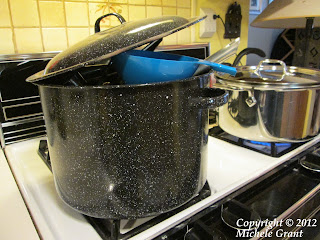Your tax dollars at work, and I don't mean that sarcastically at all: I've found an
excellent slideshow webinar from just last year (2011) about home canning. The speaker, Elizabeth Andress, Ph.D., of the University of Georgia Cooperative Extension spends a nice amount of time discussing how improperly canned food promotes the production of the botulinum toxin by
C. botulinum, and then she moves on to nuts and bolts. Useful introduction for anyone who's never canned before, and a nice review for old-timers like me.
She wraps up the webinar by suggesting that home canners pick up a few publications from the USDA and read very carefully the booklets that come with their canning supplies. Here's where CRITIC can come into play. I still have a bee in my bonnet about putting up some winter squash before the end of the month. I'd love to purée it so that I can fit more squash in each jar and thus use my pantry space efficiently. But word from the USDA and my canning supply booklets says that's a big no-no, and I should can the winter squash in cubes instead. On the other hand, look at this lovely blog entry about
canning squash -- against all
bold-faced warnings based on laboratory testing, the blog author purées the squash. Then, contrary to
specific instructions accompanying tested methods, the author leaves only a half-inch of headspace. But the jars look fine, and the author has evidently not perished, because they have continued to blog since posting their photos. And they sure do look like they know what they're doing.
The problem is that repeated laboratory testing -- laboratories, where they have instruments to digitally measure pH, temperature, air pressure, density, and so on, unlike what I can see in the blog author's kitchen -- has found
no way to formulate a consistently safe recipe for home canning a winter squash purée,
even if you add lemon juice to try to increase its acidity. This is because the chemical composition and texture of winter squash vary too much from item to item and in preparation of the food. By the time you've cooked the squash and mashed it, one batch will be watery and another, well, not so watery; and without commercial canning equipment you can't tell whether you need 60 minutes at 240 degrees F or 120 minutes. It makes for way too much variation to boil down, so to speak, for home canning instruction. (Do you have an
evaporator at home?) In other words, the USDA would argue, you can't magically make pumpkin an acid food, that is, a substance that can't promote growth of
C. botulinum bacteria, by adding lemon juice and sugar and cooking it into pumpkin butter. Apple butter is fine, because it starts with fruit, an acid food. But pumpkin butter starts with pumpkin, a low-acid vegetable. You can't get around that.
Happily, the word has
generally gotten out that home canners should preserve winter squash in chunks, not puréed. The chunks are easily mashed before use, anyway.
Whom to believe? The home canner with their photos and nice blog, or the USDA? Call me a "sheeple" but I'll go with the USDA. Two prongs of the
CRITIC test fall in the USDA's favor: the first
I and the second
C.
The claim: USDA says that home pressure canning winter squash must be done in cubes, never in purée. Home canning blogger offers method for preserving purée for purportedly safe household use.
I - What is the
information supporting the claim? The USDA labs are constantly trying recommended home canning recipes, adjusting instructions, and even sometimes withdrawing suggested methods when new data emerges. The home canning blogger has their blog and some photos. There is no follow-up blog entry (that I saw immediately) as to whether the purée canned successfully. But the USDA releases new editions of its canning guidelines frequently.
C - What
cause is proposed for the claim? The USDA gives detailed reasons in its page advising against canning winter squash purée, e.g., that they tested commercially produced and home-canned pumpkin butters that had pH levels too high to inhibit growth of
C. botulinum bacteria. The home canning blogger gives . . . nothing. There is a processing time given, but no reference to an authority, not even Grandma, for this amount of time, which is 10 minutes less than the USDA's scientifically tested time. The blogger doesn't address this discrepancy, and they don't address why they, in opposition to canning guides published by university extension offices around the country, believe that canning purée rather than cubes is safe. In short, the USDA explains its cause, but the home canning blogger offers no cause at all.
CRITIC says that I should listen to the USDA, not an Internet blogger, even though their photos make their step-by-step instructions mostly helpful. Except for that half-inch headspace thing. It should be a full one inch.






